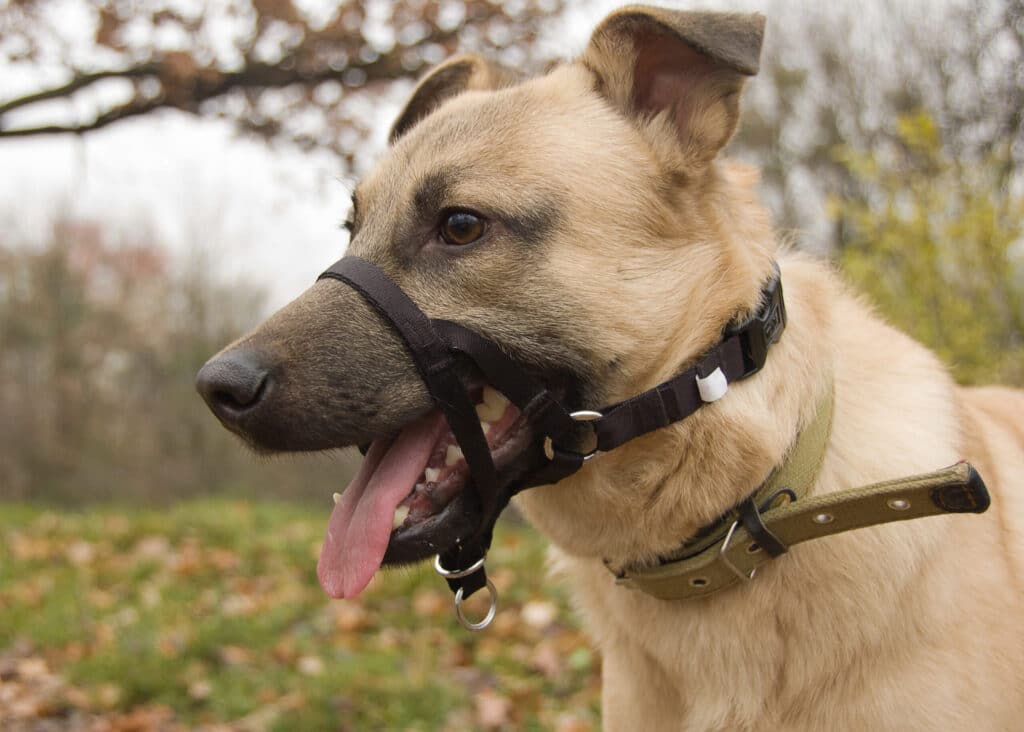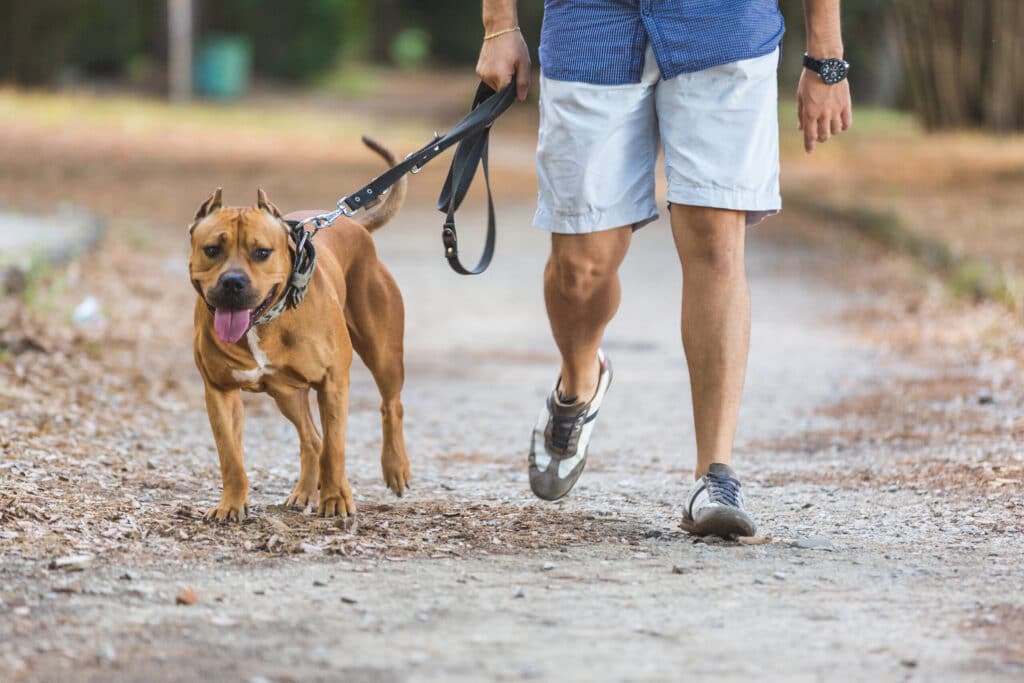How to get your dog to stop barking at other dogs?
It is usual for dogs to bark, and it is through barking that dogs communicate with us.
However, it can be frustrating when your dog barks and lunges at other dogs while the two of you are out on a walk. After all, nobody wants to spend their walk pulling on the leash every couple of minutes to control a dog barking and lunging at other dogs and people.
When looking at how to get your dog to stop barking at other dogs, it is essential to find out the reason for this behavior.
Is your dog trying to tell you something?
Barking is an outward expression of an issue that your dog is struggling with, so finding out the reason is essential.
So why does your dog bark at other dogs?
1. Fear
Your dog may bark at other dogs for many reasons, but fear is often the common cause for this behavior.
A dog walking on a leash is fearful because he cannot run away if attacked by a strange dog. Therefore, there are only two options before him: fight or flee. Since he cannot escape due to the leash, your dog has to fight, which triggers the barking.
Your dog learns through repetition that being aggressive helps keep strange dogs and people away, so it continues to bark.
2. The way you walk your dog
The way we walk our dog also can contribute to the problem.
In the world of dogs, walking straight towards another dog is considered rude and a sign of aggression.
When we allow our dog to walk ahead of us and towards another dog, we provide an opportunity for an aggressive reaction.
3. Frustration
Instead of fear, your dog may also be barking due to frustration. For example, your dog may want to play with the strange dog it has met on the road. However, the leash is preventing him from playing, and the frustration translates into barking.
It is possible to tell from your dog’s bark whether he is barking due to fear or frustration.
If the barking is because he wants to play, your dog may also playfully jump and try to draw you into the play.
4. Medical issues
A dog may also bark due to pain or other medical issues.
While you are trying to figure out why your dog is barking so much, it is advisable to consult your veterinarian to ensure there are no medical problems.
5. Insufficient socialization as a puppy
If your dog was not socialized as a puppy, he might feel anxious around other dogs or new people. It can translate into aggressive fear.
Tips on how to get your dog to stop barking at other dogs
1. Distract your dog with treats
Help your dog to learn that he can remain calm around other dogs and people while the two of you are out walking.
As you see another dog approaching, give your dog soft and delicious treats before he even has a chance to bark.
Hold out the tasty treat before your dog’s nose and have him nibble on it while walking by another dog or person.
Also, give your dog treats when he doesn’t bark while other people or dogs pass by.
2. Use a head halter

Using a head halter (a special collar that goes around the dog’s nose and neck) when going out for walks can be helpful as it helps to distract or calm your dog. But ensure that you reward your dog with a tasty treat for not barking.
Don’t let your dog wear the halter when he is unsupervised.
Avoid using a muzzle to keep your dog quiet, as it prevents dogs from panting to cool themselves.
The head halter doesn’t cause pain and efficiently keeps a dog from pulling compared to a choke chain.
3. Avoidance
It is not always possible to avoid other dogs when you are out on a walk.
However, you can ensure that you don’t take your dog straight towards another dog by avoiding sidewalks where there is a chance of encountering other dogs.
Be aware of dogs approaching head-on towards your dog and, if required, slightly alter the direction so that your dog doesn’t come face-to-face with other dogs.
4. Remember to stay calm
You must train yourself to stay calm when you see other dogs approaching.
If you get anxious, your dog will be able to sense your fear and start getting tense. Eventually, your dog will begin barking and lunging as a fear response.
Remaining calm and relaxed around other dogs will help your dog also relax, and it will allow you to think clearly about how best to handle the situation.
Don’t start the walk imagining the worst. Perhaps you have been facing aggressive encounters between your dog and other dogs almost daily, and it is only natural that you feel tense.
However, the key to helping your dog is to stay calm and think positively. Tell yourself that you will have a good experience, and your dog will also sense your positive frame of mind.
5. Be aware of how you hold the leash

When we see another dog approaching, our instinct is to shorten the leash or tighten our hold on it.
Your tension will cause you to tighten your grip on the leash, and your anxious response will indicate to your dog that you are afraid. As a result, your dog will also become tense.
As you see the other dog approaching, don’t panic, shout, tighten your hold on the leash, shorten the leash or pull on the leash. Instead, focus on staying calm and relaxed.
6. Don’t make your dog sit
Don’t use the sit command when you see another dog coming your way.
It will only make your dog anxious about the approaching threat.
Instead, it would help if you tried to distract your dog with fun activities so that he forgets about the dog heading his way.
7. Make your walks interesting
Always try to make the walks fun, challenging, and a bit unpredictable to keep your dog engaged and distracted from other dogs on his path.
Vary your speed while walking, go in circles, go back and try to walk along various terrains, and try to maneuver your way around obstacles along with your dog.
The different activities will keep your dog focused on you and not on the threat posed by the other dog.
8. Watch out for signs of over-arousal in your dog
Keep an eye on your dog to see if he is over-aroused due to the adrenaline rush from recent fearful experiences.
Your dog can experience an adrenaline rush in the following situations:
- A fight with another dog
- The tension of barking at people passing by
- Playing with other dogs
The adrenaline can stay in your dog’s system for a few days, and your dog can turn aggressive when exposed to fearful situations such as coming face-to-face with a strange dog.
If you sense that your dog is over-aroused, be careful when going out on a walk. And it is also good to avoid situations that lead to over-arousal in the first place.
9. Teach your dog to react in a different way
Along with bringing variety into the walks with your dog, you should also try to train your dog to respond calmly to the appearance of other people and dogs on the route.
The critical point is to teach your dog that running into people or other dogs while he is on the leash is pleasant and fun instead of harmful and threatening.
The training will involve the following steps:
- Start from a safe distance: Take your dog to a place where he can see another dog from a safe distance. You should be aware of what your dog considers to be a safe distance when another dog is approaching. There is a certain distance where a dog is okay to see another dog and not respond. This is where you need to be; it can be 100 yards or further, depending on your dog.
- Prevent threats: Ensure that the other dog doesn’t come towards your dog head-on or circle your dog. In the world of dogs, such actions are considered to be threatening. It will not help you with the training.
- Reward and praise: If your dog notices the other dog from a safe distance and stays calm, give him a tasty treat and plenty of verbal praise. Keep repeating the above steps for a few days to make sure that your dog is quiet when another dog is at a safe distance from him.
- Move closer: Once you are convinced that your dog can stay calm at a safe distance, you need to move closer and repeat the process of verbal praise and giving of treats. However, make sure that you don’t get close too soon; you need to gradually reduce the distance between the dogs to ensure that your dog can remain calm.
- Repetition: With consistent repetition, your dog will consider seeing other dogs while walking on a leash as a pleasant experience that gets him praise and rewards. He will no longer associate it with negativity and fear.
To overcome situations that make them tense, dogs require repeated exposure, and starting from a safe distance and gradually decreasing the space will get you good results. For more tips check out our article on 15 powerful reactive dog training tips.
10. Get her socialized
Sometimes dogs bark at other dogs while walking on a leash because they have not been socialized as puppies. It can also be due to a bad experience as a puppy at a previous home or a shelter.
It would help if you got your dog socialized by introducing her to a calm and friendly dog.
You should use treats and praise liberally to make it an enjoyable and positive experience. Also, remember to stay calm; otherwise, your dog will pick up your tension and react aggressively.
It would help if you pet the other dog and talk to the owner. When your dog sees you in a relaxed state around the other dog and the owner, he will also calm down.
If your dog keeps a distance from the other dog, don’t try to get her closer to the other dog. Instead, you should ignore your dog and give attention to the other dog.
If your dog decides to come over to you while you are with the other dog, give her plenty of praise and treats.
Remember, you should not hurry this process. It will require time, depending on the level of fear in your dog. You will have to be very patient. Initially, you may have to keep your dog on a leash to ensure no sudden outbursts of aggression.
Conclusion
You can train your dog out of his behavior of barking on walks. As mentioned, start with avoidance.
Gradually, introduce treats and praise to make encounters with other dogs a pleasant experience. Of course, it would help if you also remained calm as your dog can sense your tension and get anxious as well.
Irrespective of how well you train your dog, there can be situations where an aggressive reaction from another dog can make your dog behave fearfully and start barking. If you find yourself in such a situation, the best thing to do is immediately take your dog over to a safe distance to calm down.






